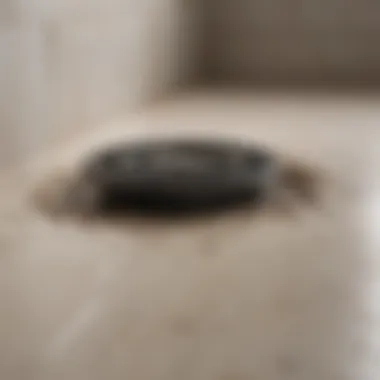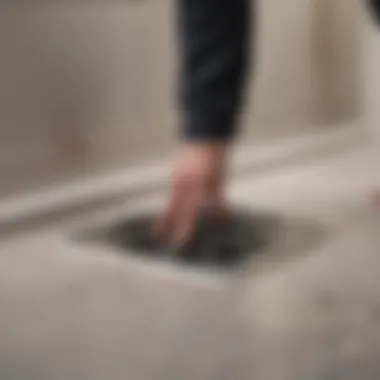Effective Solutions for a Blocked Shower Drain


Intro
A blocked shower drain is a common yet frustrating issue that many homeowners face. Understanding the causes and solutions for this problem is crucial for maintaining a functional bathroom. A blockage can lead to unpleasant smells, water pooling, and potential water damage if left unaddressed. Knowing how to effectively tackle this issue empowers individuals to manage their home maintenance tasks efficiently.
Moreover, highlighting preventative measures can significantly reduce the frequency of such problems. By adopting simple habits and utilizing the right techniques, homeowners can ensure smoother drainage. This guide will present a range of approaches, from easy DIY fixes to professional solutions, ensuring you have the knowledge and tools necessary to resolve this common household inconvenience.
In this article, we will explore essential information to help you navigate through effective solutions for blocked shower drains.
"Regular maintenance of shower drains is key to preventing blockages and prolonging the life of your plumbing."
By understanding both the issues and the practical strategies to resolve them, you can maintain a healthier and more functional bathroom environment.
Understanding Shower Drains
Types of Shower Drains
Point Drain
A point drain is a widely recognized design in shower drainage systems. It consists of a central grate where water collects and drains away efficiently. This type is defined by its discrete placement at a single point in the shower floor. The primary advantage of a point drain is its simplicity and effectiveness in smaller shower spaces. However, its effectiveness can decrease in larger showers where water may not flow towards the drain efficiently. This can sometimes lead to water pooling, an undesirable situation for users.
Linear Drain
Linear drains offer a modern alternative to point drains. They are typically installed along the side of a shower and extend in a straight line, capturing water across a wider area. One key characteristic is their aesthetic appeal, which fits well in contemporary designs. They facilitate faster drainage, reducing the risk of blockages. Nonetheless, installation might require precise leveling to ensure optimal performance, which could increase initial costs and complexity.
Trench Drain
Trench drains are similar to linear drains but are generally wider and deeper. They are often utilized in larger showers or wet rooms where substantial water flow is expected. The significant advantage of trench drains is their ability to handle a large volume of water effectively, minimizing the chances of blockage. However, they require more space and can be more challenging to install as they necessitate adequate height and slope for proper drainage.
Functionality of Shower Drains
Water Flow Mechanics
Understanding water flow mechanics is crucial for the effective operation of any shower drain. Essentially, water should flow from various points across the shower floor towards the drain. The design of the shower, including its slope, determines how effectively the water is directed. A proper slope ensures that water does not pool and consequently reduces the likelihood of clogs, making it an essential consideration during installations and renovations.
Gravitational Forces in Drainage
Gravitational forces are another significant element in shower drainage functionality. Water drainage relies heavily on gravity to pull the water down through the pipes. The alignment and gradient of the pipes are vital to ensure that water flows smoothly without stagnation. If gravity is not adequately harnessed due to improper installation or pipe degradation, blockages can develop over time, leading to annoying and costly inconveniences.
Common Causes of Blocked Shower Drains
Understanding the common causes of blocked shower drains is essential for effective home maintenance. Identifying these causes not only aids in resolving current issues but also helps prevent future blockages. Homeowners and renters alike benefit from being knowledgeable about the factors that contribute to shower drain problems. With this positive knowledge, you can maintain a functional drainage system and ensure smooth water flow.
Hair Accumulation
Hair is a prevalent cause of clogs in shower drains. Over time, strands of hair work their way into the drain, forming a tangled mess that impedes water flow. This situation often worsens when combined with soap residue, leading to significant blockages. Regular cleaning can mitigate this issue; using a drain cover can also catch hair before it enters the drainage system. It's important to note how even a small amount of hair can develop into a substantial clog if not managed promptly.


Soap Scum and Residue
Soap scum is another leading cause of shower drain blockages. This residue forms as soap interacts with minerals in the water. It creates a sticky layer that attracts debris and hair, compounding the blockage issue. Regular scrubbing of the shower area helps to minimize soap scum build-up. It is wise to consider using low-residue soap alternatives. Doing so can significantly lessen the amount of soap scum produced, assisting in prolonging the health of your drain.
Foreign Objects
Often, foreign objects find their way into shower drains, leading to unexpected clogs. Items such as shampoo caps, cotton swabs, or even small toys can cause significant drainage issues. Once lodged, these items can create barriers preventing water from flowing freely. Conducting a thorough visual inspection can help identify visible foreign objects. Preventing this issue can be as simple as educating family members about what should and should not be sent down the drain.
Pipe Damage or Corrosion
Pipe damage or corrosion is a more complex cause of blocked drains. Over time, pipes can degrade due to age or harsh cleaning chemicals. Corrosion can lead to narrow passages or cracks, impeding water flow and welcoming the accumulation of debris. Periodic inspections for signs of wear can help identify the need for repairs or replacements before severe damage occurs. If you suspect you have corroded pipes, it is advisable to seek expert assistance. Taking these steps can spare you from extensive repairs down the line.
Initial Assessment of the Blockage
An effective management of a blocked shower drain begins with a proper assessment of the situation. The initial assessment is critical as it helps identify the nature and extent of the blockage. Such evaluation can determine whether minor interventions are needed or if professional assistance is required. Properly assessing the blockage also allows homeowners to avoid unnecessary trial-and-error solutions that may lead to further complications.
Visual Inspection
Visual inspection is often the first step in diagnosing a blocked shower drain. It is an essential part of the initial assessment process. By closely examining the shower area, one can gather vital information about the blockage.
Checking for Surface Blockages
Checking for surface blockages involves looking at the visible areas around the drain. This includes any hair, soap scum, or debris that might be clogging the opening. It is a straightforward approach and often provides immediate insights into the problem.
A key characteristic of checking surface blockages is its ease; anyone can do it without special tools. This makes it a popular choice for homeowners seeking quick solutions. By removing any visible materials, you may improve drainage significantly without additional measures. However, it is essential to note that this approach may not capture deeper issues causing the blockage.
Assessing Drain Grate Condition
Assessing the drain grate condition involves evaluating the physical state of the drain cover. This includes checking for cracks, rust, or accumulated debris obstructing the opening. The condition of the grate can significantly impact overall drainage performance.
A well-maintained grate allows water to flow freely, while a damaged one may contribute to recurring blockages. Regular evaluations of the drain grate can prevent more extensive issues in the long run. The unique aspect of this approach is that it highlights the importance of infrastructure — without good drainage covers, problems can easily arise. However, if the grate is not the issue, further investigation into the plumbing system may be necessary.
Water Flow Test
The water flow test is a practical method to assess the severity of a blockage. By running water through the drain, one can observe its performance. If water is sluggish or fails to drain completely, this indicates a significant obstruction. This simple test can reveal how quickly the drain responds.
Homeowners might use this test in conjunction with their previous observations. By linking visual inspections with water flow performance, the overall picture becomes clearer. Additionally, it aids in deciding the best approach for future remedies.
DIY Solutions for Clearing Blocked Shower Drains
Blocked shower drains can cause significant inconvenience in daily routines. The importance of DIY solutions lies in their accessibility and cost-effectiveness. Many homeowners can resolve minor blockages without the need for professional plumbing services. By understanding these methods, readers can empower themselves to maintain their shower drains effectively.
DIY approaches also foster a sense of control over home maintenance tasks and can save both time and money. In the following sections, we will explore various methods to address the common issue of blocked shower drains.
Boiling Water Flush


One of the simplest and most effective methods to clear a blocked shower drain is the boiling water flush. This technique works particularly well for removing soap scum and other grease that can build up over time. To perform this method:
- Boil a kettle of water. Ensure that the water is at a rolling boil.
- Carefully pour the boiling water down the drain in increments. Allow each pour a couple of minutes to work before adding more.
This method can often clear blockages quickly. However, exercise caution since boiling water can damage certain pipe materials.
Baking Soda and Vinegar Method
The baking soda and vinegar method is another popular DIY solution, harnessing the chemical reaction between the two substances to help break down clogs. To use this method, follow these steps:
- Pour half a cup of baking soda into the drain. Allow it to sit for a few minutes.
- Add half a cup of vinegar. You may hear fizzing as the two ingredients react; let this sit for 15 to 20 minutes.
- Flush the drain with hot water. This helps to clear any remaining debris.
This method is eco-friendly and uses common household ingredients, making it appealing.
Using a Plunger
Employing a plunger can be highly effective for more stubborn blockages. A plunger creates a vacuum that can dislodge trapped materials. Here is how to use it:
- Ensure there is some water in the shower base. The water should cover the plunger's cup.
- Place the plunger over the drain. Ensure a tight seal is formed.
- Push down and pull up rapidly. Repeat this motion several times, then check if the water begins to flow freely again.
The effectiveness of this method can depend on the type of blockage present. It is a straightforward technique that may require some persistence, but it often yields significant results.
Plumbing Snake Application
A plumbing snake is a tool designed for tackling deeper clogs that other methods fail to clear. It is particularly useful for hair accumulations or foreign objects lodged deeper within the pipes. To use a plumbing snake:
- Insert the snake into the drain opening. Push it down slowly until you feel resistance.
- Rotate the handle. This helps in breaking apart the clog or snagging debris.
- Pull the snake out slowly. Make sure to remove any materials that have been dislodged.
While using a plumbing snake requires some effort and may seem unpleasant, it can effectively restore the proper flow in your shower drain.
When to Seek Professional Help
Addressing a blocked shower drain can be a straightforward task in many cases. However, knowing when to call a professional is equally important. Homeowners may try various DIY methods but sometimes these are insufficient. Ignoring persistent issues can lead to larger problems, potentially involving significant damage to the plumbing system. Therefore, understanding the key indicators can save time and money.
Signs of Persistent Blockages
Recognizing the signs that a problem persists is essential. Here are several indicators:
- Water Level Issues: If water takes longer to drain after attempting DIY methods, this is an unresolved problem.
- Recurring Blockages: Experiencing multiple blockages over a short period indicates an underlying issue.
- Unusual Odors: Foul smells can signify not just debris, but possible pipe problems that a homeowner cannot address alone.
- Water Backflow: If waste water backs up, it's a serious condition requiring immediate attention. This could indicate blockage deeper in the system.
These signs warrant consideration for professional assessment.
Identifying Structural Issues
Sometimes blockages are symptomatic of larger structural problems. Factors that suggest a deeper issue include:


- Old or Damaged Pipes: Aging pipes can corrode or crack, leading to persistent blockages. If your home has old plumbing, this could be a significant factor.
- Improper Drain Installation: If the installation angle is incorrect, it can create continuous drainage issues.
- Tree Root Intrusion: Roots from nearby trees can invade drainage systems, causing severe blockages. This requires specialized equipment for proper removal.
These considerations are complex and usually need a professional's expertise. They can provide the diagnosis and treatment plan needed for resolution.
Cost Considerations for Professional Services
Engaging a plumbing professional comes with its own set of considerations, particularly regarding cost. It's essential to understand what factors influence these costs:
- Severity of the Blockage: Simple blockages typically entail lower fees compared to more complicated issues like pipe replacement.
- Location and Accessibility: If pipes are difficult to access or buried, this adds to labor costs.
- Emergency Services: After-hours calls typically incur a premium charge.
While the cost may seem high, the potential expense of further damage from neglect can outweigh it. Investing in professional services provides peace of mind and ensures your plumbing system operates smoothly.
"Knowing when to call in professionals can often save significant time and expense in the long run."
Preventative Measures for Shower Drain Maintenance
Preventing issues with shower drains is essential for maintaining a functional plumbing system. By implementing basic measures, homeowners can save time and money on considerable repairs. Keeping drains clear leads to better hygiene and a more pleasant showering experience. Regular care can prolong the lifespan of plumbing and ensure the efficient flow of water. Here are two effective strategies to maintain your shower drains and prevent blockages.
Using Drain Screens
Drain screens are an effective barrier against debris that may enter your shower drain. They catch hair, soap particles, and other materials before they can accumulate and create blockages. Many homeowners find that installing a quality drain screen is simple and low-cost. By using a screen, it is easier to catch potential clog dangers early on. The key characteristic of drainage screens is their ability to effectively trap unwanted substances without hindering water flow. However, for the system to work efficiently, the screens must be cleaned regularly to avoid overflow. An unclean screen can lead to backup, defeating the purpose.
Regular Cleaning Routines
Monthly Maintenance Tips
Implementing monthly maintenance is a crucial part of shower drain care. This routine involves a few simple steps, such as removing the drain cover and cleaning debris away. The idea is to check the condition of the drain at least once a month. Washing the area with warm water and basic cleaner can break down any soap scum. This practice is beneficial because it keeps blockages at bay before they escalate. The unique feature of this method is its simplicity; there is no need for special tools or products, just daily cleaning supplies. Its disadvantage is that it requires commitment from the homeowner to stick to the schedule.
Seasonal Deep Cleaning Recommendations
Cleaning deeply once each season is another important step in preventative maintenance. Seasonal cleaning involves inspecting the entire drain system, which may include using a plumbing snake to clear any build-up that might be hidden. This thorough cleaning keeps things fresh and prevents slow drainage issues. It is advisable to perform seasonal cleanings during times when the shower is less used, like after summer. The unique advantage of this method is it offers peace of mind knowing that the drain is fully inspected and maintained at least four times a year. A potential drawback is that this process can be labor-intensive, which some homeowners may find daunting.
Long-term Solutions for Drain Health
Long-term solutions for maintaining shower drain health are integral for preventing recurring blockages. Regularly addressing these issues saves homeowners from both the hassle of immediate repairs and the costs associated with long-term damage to drainage systems. Understanding the significance of effective maintenance, as well as proactive strategies, ensures a functional and efficient drainage system. A fresh approach to drain health not only enhances performance but also extends the life of plumbing systems.
Upgrading Drainage Systems
Upgrading drainage systems can significantly alter how efficiently water flows through the pipes. Modern drainage solutions often feature improved materials and designs. Consider the benefits:
- Materials Durability: Newer materials like PVC resist corrosion and wear over time.
- Flow Capacity: Advanced designs increase flow capacity, reducing blockages.
- Installation of Trench Drains: These systems can be effective for areas with high water accumulation, distributing the volume evenly.
Investing in upgraded drainage can be a sound strategy for homes prone to blockages. Homeowners should assess the current system's capacity in relation to their usage and consider professional consultation for tailored improvements.
Pipe Inspection Technology
The emergence of innovative pipe inspection technology has revolutionized the way we maintain shower drains. Tools like CCTV cameras offer an in-depth view of the drainage system without invasive methods. Here are some considerations:
- Early Detection: Identifying issues such as cracks or blockages early means addressing them before they escalate.
- Cost-Effectiveness: Addressing small problems early can prevent expensive repairs later.
- Enhanced Analysis: These technologies provide precise information about pipe conditions, allowing for a more targeted approach to repairs.
"Investing in pipe inspection technology can save not only money but also time in the long run."
For those committed to drain health, these long-term solutions reveal a proactive mindset. Home maintenance becomes manageable, preventing future issues and maintaining optimal functionality.







